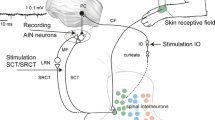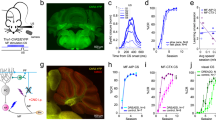Abstract
Field potentials induced in deep cerebellar nuclei by the electrical stimulation of contralateral red, pontine and reticularis tegmenti pontis oralis nuclei, the restiform body and the inferior olive were recorded in the alert cat. Recording sites in interpositus and fastigial nuclei were selected with the aid of antidromic field potentials induced by red nucleus and restiform body stimulation, respectively. Pontine and reticularis tegmentipontis oralis nuclei stimulation induced small, but constant amplitude, field potentials consisting of one or two negative waves. Control field potentials induced by inferior olive stimulation consisted of a negative wave at 2–3 ms followed by a late (4–6 ms) positivity. Conditioning stimuli applied to the pontine and reticularis tegmenti pontis oralis nuclei greatly enhanced the amplitude of the inferior olive-evoked synaptic field potential for a time window of about 40 ms. In contrast, inferior olive conditioning stimulation failed to modify the field potentials induced by pontine nuclei stimulation. These facilitatory effects on field potential amplitude showed no long-lasting modifications. The transient modification of inferior olive-induced field potentials could be related to attentional movements made by the animal to natural or electrically-induced sensory cues.
Similar content being viewed by others
References
Albus J (1971) A theory of cerebellar function. Math Biosci 10:25–61
Courville J, Augustine JR, Martel P (1977) Projections from the inferior olive to the cerebellar nuclei in the cat demonstrated by retrograde transport of horseradish peroxidase. Brain Res 130:405–419
Delgado-García JM, Gruart A (1994) Signaling properties of deep cerebellar nuclei neurons. In Ferrell WR, Proske U (eds) Neural control of movement. Plenum Press, New York (in press)
Delgado-García JM, Vidal PP, Gómez C, Berthoz A (1989) A neurophysiological study of prepositus hypoglossi neurons projecting to oculomotor and preoculomotor nuclei in the alert cat. Neuroscience 29:291–307
Gruart A, Blázquez P, Delgado-García JM (1994) Variability of climbing fiber effects on deep cerebellar nuclei neurons in the alert behaving cat. In: Delgado-García JM, Godaux E, Vidal PP (eds) Information processing underlying gaze control. Pergamon Press, London (in press)
Gruart A, Pastor A, Delgado-García JM (1993) Variability of climbing fiber effects on deep cerebellar nuclear neurons during spontaneous and experimentally-induced eye and eyelid movements. Soc Neurosc Abstr 19:401.7
Ito M (1984) The cerebellum and neural control. Raven Press, New York
Ito M (1989) Long-term depression. Ann Rev Neurosci 12:85–102
Ito M, Yoshida M, Obata K, Kuwai W, Udo M (1970) Inhibitory control of the intracerebellar nuclei by the Purkinje cell axons. Exp Brain Res 10:64–80
Krupa DJ, Thompson JK, Thompson RF (1993) Location of a memory trace in the mammalian brain. Science 260:989–991
Lisberger SG (1988) The neural basis for learning of simple motor skills. Science 242:728–735
Llinás R (1991) The noncontinuous nature of movement execution. In: Humphrey DR, Freund HJ (eds) Motor control: concepts and issues. John Wiley and Sons, New York, pp 223–242
Llinás R, Mühlethaler M (1988) Electrophysiology of guinea-pig cerebellar nuclear cells in the in vitro brain stem-cerebellar preparation. J Physiol (Lond) 404:241–258
McDevitt CJ, Ebner TJ, Bloedel JR (1987) Changes in the responses of cerebellar nuclear neurons associated with the climbing fiber response of Purkinje cells. Brain Res 425:14–24
Muri R, Knöpfel Th (1994) Activity induced elevations of intracellular calcium concentration in neurons of the deep cerebellar nuclei. J Neurophysiol 71:420–428
Shinoda Y, Sugiuchi Y, Futami T, Izawa R (1992) Axon collaterals of mossy fibers from the pontine nucleus in the cerebellar dentate nucleus. J Neurophysiol 67:547–560
Thach WT, Kane SA, Mink JW, Goodkin HP (1992) Cerebellar output: multiple maps and modes of control in movement coordination. In: Llinás R, Sotelo C (eds) The cerebellum revisited. Springer, New York, pp 283–300
Author information
Authors and Affiliations
Rights and permissions
About this article
Cite this article
Gruart, A., Blázquez, P., Pastor, A.M. et al. Very short-term potentiation of climbing fiber effects on deep cerebellar nuclei neurons by conditioning stimulation of mossy fiber afferents. Exp Brain Res 101, 173–177 (1994). https://doi.org/10.1007/BF00243229
Received:
Accepted:
Issue Date:
DOI: https://doi.org/10.1007/BF00243229




